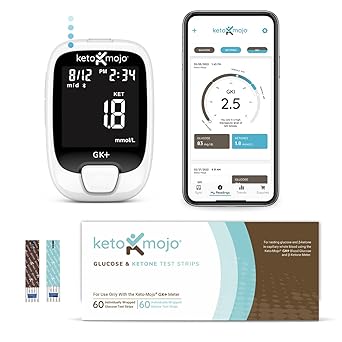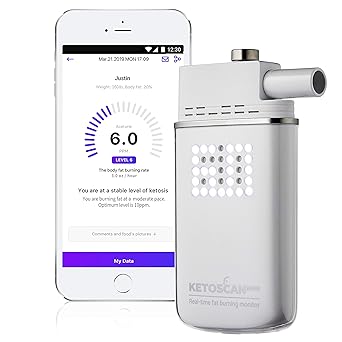So, you've cut the carbs, upped the fat following the Keto Beginner's Guide, and you're pretty sure you're doing this keto thing right. But how do you know if your body has actually made the switch into ketosis? That's where ketone testing comes in.
Measuring your ketone levels can provide valuable feedback, helping you understand how different foods affect you, confirm you're on the right track, and troubleshoot if your progress stalls. But with different methods available – urine strips, blood meters, breath analyzers – which one is right for you?
This guide breaks down the common ways to test for ketones, their pros and cons, and how to make sense of the results.
Why Test for Ketones?
While not strictly necessary for everyone following keto (especially if you're feeling great and seeing results), testing can be helpful for:
- Confirmation: Confirming you are actually in nutritional ketosis, especially when starting out.
- Troubleshooting: Identifying if hidden carbs or certain foods are kicking you out of ketosis (See Common Keto Mistakes) or contributing to a stall (See Overcoming Keto Plateaus).
- Optimization: Understanding how different meals (and their macros), exercise, or stress levels impact your ketone levels.
- Motivation: Seeing positive ketone readings can be encouraging!
- Therapeutic Keto: For those using keto for specific medical reasons, precise monitoring is often required.
Method 1: Urine Ketone Strips
These are often the first method beginners try due to their low cost and ease of use.
 Urine strips are easy to use but measure excess ketones, which can decrease over time.
Urine strips are easy to use but measure excess ketones, which can decrease over time.
- How they work: Detect excess Acetoacetate (AcAc) ketones spilled into the urine.
- How to use: Briefly dip the strip pad into a urine stream or collected sample, wait the specified time (usually 15-60 seconds), and compare the pad color to the chart on the bottle.
- Pros: Inexpensive, widely available, easy to use, non-invasive.
- Cons:
- Measures excess ketones: As your body becomes more "fat-adapted" (a process explained in the Beginner's Guide), it gets better at using AcAc and BHB, so less AcAc spills into the urine. This means strips can become less reliable or show lower readings over time, even if you're still in deep ketosis.
- Hydration affects results: Being dehydrated can concentrate urine and make readings appear darker (higher), while being very hydrated can dilute it and make readings appear lighter.
- Not precise: Provides a range (trace, small, moderate, large) rather than an exact number.
- Best For: Beginners confirming they've initially entered ketosis (first few weeks). Less useful for long-term monitoring or optimization.
- What the results mean: Any color change (pink to purple) indicates the presence of ketones. Darker doesn't necessarily mean "better" ketosis, especially long-term. (Read more: What Does KET Mean on a Urine Test?)
Method 2: Blood Ketone Meters
Considered the "gold standard" for accuracy by many keto experts.
 Blood meters provide precise BHB ketone readings.
Blood meters provide precise BHB ketone readings.
- How they work: Measure Beta-hydroxybutyrate (BHB), the main ketone circulating in your blood, using a small blood sample (finger prick).
- How to use: Insert a ketone test strip into the meter, use a lancet device to prick your finger, apply the small blood drop to the strip, and wait a few seconds for the reading.
- Pros:
- Accurate & Precise: Measures the primary fuel ketone (BHB) directly in the blood, giving a specific numerical value (usually in mmol/L).
- Reliable Long-Term: Readings remain accurate even after fat adaptation.
- Real-Time Data: Shows your current ketone level.
- Cons:
- More Expensive: Meters and especially test strips cost significantly more than urine strips.
- Invasive: Requires a finger prick each time.
- Best For: Those serious about tracking, optimizing diet, troubleshooting plateaus, or using keto therapeutically.
- What the results mean (General Ranges):
- Below 0.5 mmol/L: Not considered ketosis.
- 0.5 - 1.5 mmol/L: Light nutritional ketosis.
- 1.5 - 3.0 mmol/L: Optimal nutritional ketosis (often recommended for weight loss/health benefits).
- Above 3.0 mmol/L: Deeper ketosis (not necessarily better unless for specific therapeutic reasons).
- Note: Dangerously high levels (15+ mmol/L) occur in diabetic ketoacidosis (DKA), a serious medical condition unrelated to nutritional ketosis in non-diabetics.
- Popular Meter: Keto-Mojo is a well-regarded brand, and their GK+ Meter Kit is an excellent choice. It measures both blood glucose and ketones, providing valuable insights into how your meals affect both metrics. The kit includes the meter, lancets, and a starting set of test strips. It also syncs with a free app to track your readings and calculate your GKI (Glucose Ketone Index), a key indicator of metabolic health.
Featured Product: Keto-Mojo GK+ Kit
The Keto-Mojo GK+ is highly recommended by keto experts for its accuracy in measuring both blood ketones (BHB) and glucose. The app integration makes tracking trends and calculating your GKI simple. While the strips are an ongoing cost, the data provided is invaluable for optimizing your diet and troubleshooting issues.
Check Price on AmazonMethod 3: Breath Ketone Analyzers
These measure Acetone, another ketone byproduct, in your breath.
- How they work: You breathe into the device for a specified time, and it provides a reading based on acetone concentration.
- How to use: Follow the specific device instructions (usually involves turning it on, waiting for calibration, then breathing steadily into it).
- Pros:
- Non-invasive: No finger pricks.
- Reusable: No ongoing cost for strips (after initial device purchase).
- Convenient: Easy to use anywhere, often syncs with apps for tracking.
- Cons:
- Variable Accuracy: Readings can be influenced by factors like alcohol consumption, hydration, and even breathing technique. Generally considered less accurate than blood meters for precise BHB levels, with some users reporting inconsistent results.
- Measures Acetone, not BHB: While acetone levels correlate with ketosis, the relationship isn't always direct or linear with BHB.
- Initial Cost: Devices can be expensive upfront.
- Recalibration/Replacement: Some models require periodic sensor recalibration or replacement.
- Units Vary: Devices use different units (PPM, ACEs), making comparisons sometimes tricky.
- Best For: Those who want frequent, non-invasive trend monitoring without the cost of blood strips, but understand it's less precise than blood testing and requires consistent usage technique.
- Example Devices: Brands like KETOSCAN offer popular breath analyzers.
- The KETOSCAN Mini is a portable option that syncs with an app but requires sending the device back for sensor replacement after ~300 uses.
- The KETOSCAN SMART features a user-replaceable sensor cartridge and a color LCD, but has more mixed reviews regarding consistency compared to the Mini.
Breath Analyzer Option: KETOSCAN Mini
The KETOSCAN Mini offers a convenient, non-invasive way to track ketone trends by measuring breath acetone. It connects to an app for logging data. While generally less precise than blood meters, many find it useful for daily monitoring without finger pricks, though sensor replacement requires sending the unit back.
Check Price on AmazonWhich Method Should You Choose?
- Beginner (First Few Weeks): Urine strips are a cheap and easy way to confirm you're starting to produce ketones.
- Serious Tracking/Optimization/Troubleshooting: Blood ketone meters offer the most accurate and reliable data.
- Frequent, Non-Invasive Trend Monitoring: Breath analyzers are convenient if you accept potentially lower precision and higher upfront cost.
Ultimately, the best method depends on your budget, goals, and how much data you want. Remember that testing is just one tool – focus also on how you feel, your energy levels, and your overall health progress!


